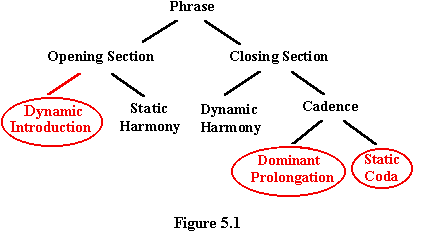
CHAPTER 5 (PART 1)
EXTENSIONS WITHIN THE BASIC STRUCTURE
Introduction
All harmonic structures in tonal music derive from the basic phrase structure as explained in Chapter 1. The basic syntactic structure can be extended in various ways, just as sentence structures in language can be. In this chapter we will consider extensions within the basic phrase structure and in the next chapter extensions outside of the basic structure.
There are three types of extension possible within the basic musical phrase structure:
- The dominant chord of the cadence can be prolonged by static harmony in a similar way to the way the tonic chord is prolonged in the static harmony in the opening section. This has the effect of extending the cadence. I will refer to this as a dominant prolongation. This extension is very common.
- The tonic chord of the cadence can be prolonged by static harmony. This has the effect of delaying the end of the phrase. This I will refer to as a static coda. This is also a common extension to the basic structure.
- The opening section, can be subdivided into two sections. In this
case, the initial static harmony is preceded by a dynamic element that
I will refer to as a dynamic
introduction. This is a kind of extended upbeat or lead-in to the
static harmony. This occurs less frequently than the previous two types
but is an important way of extending the opening section harmony.
The following diagram shows all three types of extension in place in the syntactic structure. They may be present individually or in any combination.
This diagram shows the most complete form of the syntactic structure without external extensions:


